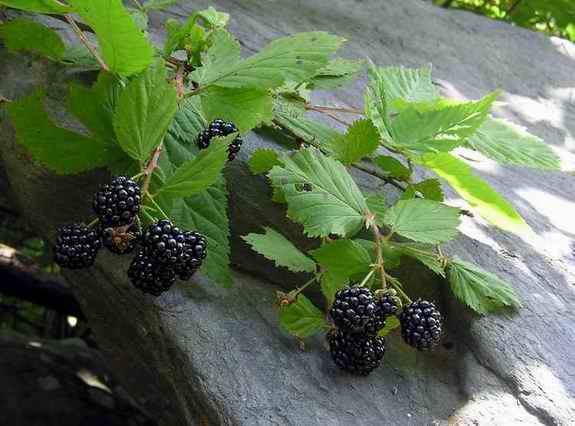|
Common Name: Blackberry, Allegheny Blackberry, Highbush Blackberry, Bramble, Brambleberry, Bumble-Kite, Brummel, Brameberry, Scaldhead Scientific Name: Rubus allegheniensis (The generic name is Latin for bramble-bush, and applies to all brambles: blackberry, raspberry, loganberry, wineberry and cloudberry; the species name distinguishes the Allegheny habitat). It is one of about 100 genera of the Rose family; also known as R. villosus var montanus.
Blackberries have been consumed by humans for millennia, as confirmed by the fossil record. The seed pips, easily distinguished by their unusual diamond shaped pattern, have been found in interglacial strata throughout Europe, most notably in the stomach of a Neolithic man extracted from the Essex clays of England in 1911. They are included in the works of the Greek playwright Aeschylus and the Metamorphoses of the Roman poet Ovid who lauded the consumption of wild foods.
There are over 300 species of blackberries in the temperate regions of the world and in many places they are considered a nuisance. They smother other native plants in open areas, wreak havoc among livestock and humans seeking access to paths, are injurious to grazing livestock and provide breeding places for rats. Considered a weed in Europe, they were first brought into commercial cultivation in America, when Captain J. Lovett of Beverly, Massachusetts started the first commercial operation in 1835 with R. allegheniensis.
The blackberry as medicinal parallels its consumption as an edible fruit. Mentioned by Hippocrates, the father of medicine, the blackberry was prescribed by the ancient Greeks as a treatment for gout. Pliny the Elder listed the blackberry as an astringent useful in the treatment of diarrhea and as a palliative for the treatment of sore gums and tonsils. In North America, the Allegheny Blackberry was of great importance as a medicine to Native Americans, most notably as a treatment for diarrhea and other diseases of the lower intestinal tract. This practice was adopted by early settlers, who made a jam of the blackberries for this purpose.
The medicinal benefit of the blackberry extended to superstition. In medieval England, the arch made by a bramble that rooted at both ends was believed to provide a cure for hernia or rupture in children; the afflicted child was passed backwards and forwards through the arch. A similar treatment is still in use in Cornwall, where children are passed through a slit in the trunk of an ash sapling which is afterward bound up to affect a cure. A bramble-cure of this sort was also used to heal boils, blackheads and rheumatism in adults, who either crawled or were dragged beneath a bramble shoot. The name scaldhead for the blackberry is due to the belief that children who ate the fruit to excess became afflicted with a disease of the scalp called scald head.
However, due to the propensity of brambly blackberries to invade any open habitat with a dense, impenetrable mass of thorny stems, the plant garnered a tarnished reputation to act as counterpoint to its medicinal attributes. It was imbued with the superstitious belief that the devil urinated on the plants at Michaelmas (September 29) making the berries unfit for consumption. Perhaps this was to dissuade children from eating them and getting scald head. Graves were tangled with brambles as a means of keeping the spectral inhabitants from ghostly forays amongst the living. A superstition likely related to this is that blackberries gathered during the appropriate cycle of the moon were thought to provide protection against evil spirits.
The ubiquity of the blackberry is due to two factors: a highly successful life cycle and a robust heterogeneity. Blackberries produce prodigious blossoms and copious fruits. The flowers are pollinated primarily by bumblebees and honeybees, but they can be self-pollinating. The fruits are consumed by many animal species so that the seeds are widely spread to new areas. The seeds have a very hard coat that can remain viable in a dormant state for long periods. When the seed germinates, a perennial root structure is produced that yields biennial shoots called canes. The canes develop on root buds, grow the first year and flower and fruit in the second. Once established, the blackberry grows almost entirely by underground stems called rhizomes. The plant lives for about 25 years.
Blackberries, like about half of all flowering plants, are polyploidal. This means that the cells have a multiple of the parental chromosome number and can readily hybridize. This condition arises when the germ (sex) cell with half of the number of chromosomes (called a haploid) combines with another cell with a normal full set of chromosomes (called a diploid) to create a cell with three sets of chromosomes (a triploid). Other multiples result in polyploids. This propensity is widely used by plant breeders to produce cultivars (there are triploid bananas and tetraploid potatoes). . |
